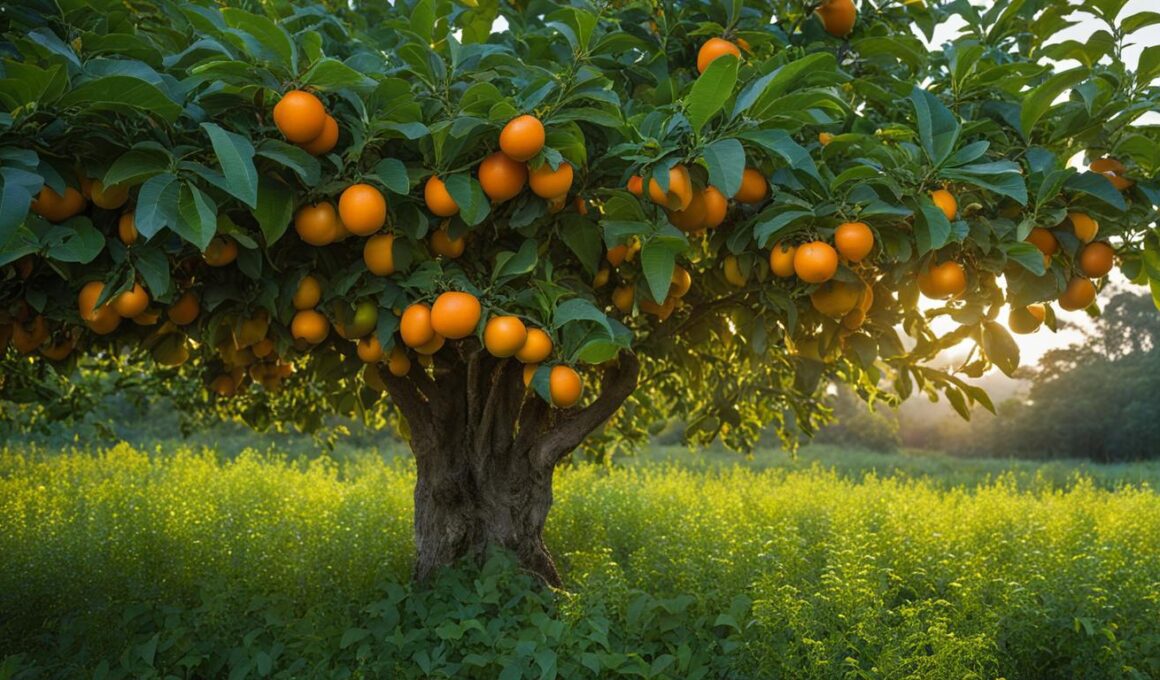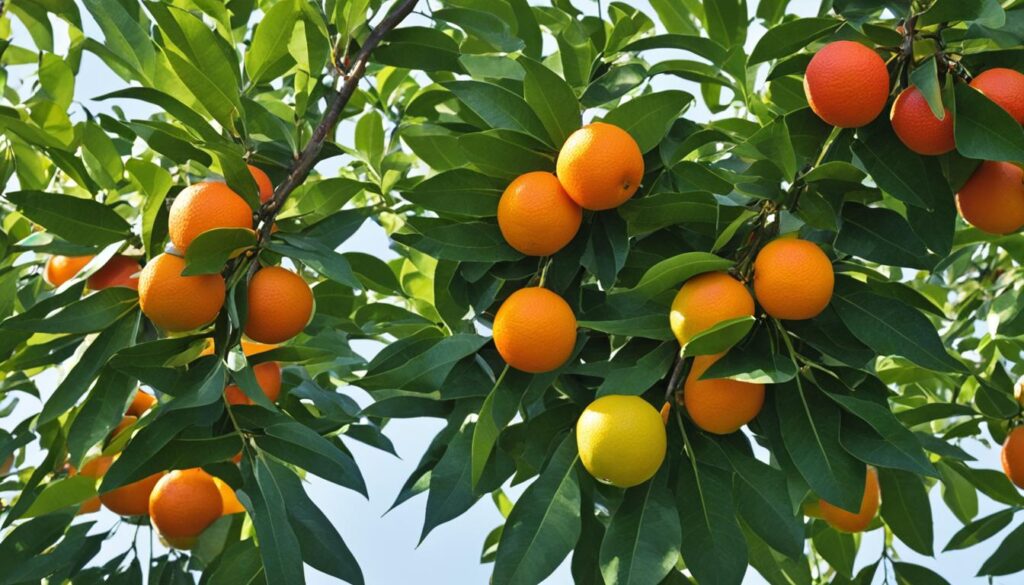A persimmon tree is a delightful addition to any landscape, adding vibrant colors and unique beauty. If you’re curious about the characteristics and appearance of a persimmon tree, you’ve come to the right place. In this article, we will explore the foliage, fruit, and overall appearance of these fascinating trees.
Let’s start with the foliage. The leaves of a persimmon tree are initially blue-green in color, providing a calming and refreshing atmosphere. However, as autumn approaches, these leaves undergo a dramatic transformation, turning into a breathtaking range of yellow and orange hues. The sight of a persimmon tree in full fall foliage is truly a sight to behold, creating a warm and inviting ambiance in your garden.
Now, let’s talk about the fruit. The fruit of a persimmon tree is small, round, and jelly-like. As it ripens, it takes on a beautiful dark red to maroon color, resembling nature’s own little gems. With their sweet and rich flavor, persimmons can be enjoyed in a variety of delectable dishes, from pies and puddings to jams and smoothies.
When it comes to the appearance of the tree itself, persimmons have a distinctive charm. The most commonly cultivated species, Diospyros kaki, can reach heights of 4.5 to 18 meters, providing an elegant and imposing presence in your garden. In the United States, the American persimmon (Diospyros virginiana) is a native species that can grow up to 10 meters and adapts well to various climates.
Whether you’re drawn to their dazzling foliage, delicious fruit, or striking presence, persimmon trees are a captivating addition to any outdoor space. In the following sections, we will explore different types of persimmon trees, their characteristics, growth patterns, and essential care tips to help you cultivate these magnificent trees with ease.
Types of Persimmon Trees
When it comes to persimmon trees, two main types stand out: the American persimmon (Diospyros virginiana) and the Japanese persimmon (Diospyros kaki). Both varieties offer unique characteristics and luscious fruit that are sure to delight your taste buds.
The American persimmon is native to the United States and can reach impressive heights of up to 60 feet. It features oblong, bluish-green leaves that transform into vibrant shades of yellow and orange during the fall season. The fruit of the American persimmon is pumpkin-shaped and comes in a pale or dark orange hue. Known for its rich flavor, the American persimmon is perfect for baking, making preserves, or enjoying fresh.
On the other hand, the Japanese persimmon originated in East Asia and has become increasingly popular worldwide. It boasts glossy, bluish-green leaves that add an elegant touch to any garden. The fruit of the Japanese persimmon is more circular and acorn-like in shape, with a darker orange color. Japanese persimmon varieties offer a spectrum of flavors, ranging from sweet and custard-like to tangy and crisp.
Whether you prefer the unique taste of the American persimmon or the diverse flavors of Japanese persimmons, both types of persimmon trees are sure to be a delightful addition to your landscape. Their vibrant foliage, distinct fruit characteristics, and delectable flavors make them a favorite among gardeners and fruit enthusiasts alike.
Next, we’ll explore the fascinating characteristics and appearance of persimmon trees in more detail. Stay tuned!
Characteristics and Appearance
*The size of a persimmon tree can vary depending on the species.* American persimmon trees typically grow up to 10 meters in height, while Diospyros kaki can reach heights of 4.5 to 18 meters. The growth of a persimmon tree is influenced by various factors such as soil quality, climate, and pruning techniques. It is essential to provide adequate space for the tree to grow and thrive.
*The leaves of a persimmon tree are a defining feature of its appearance.* They are glossy, dark green, and provide a lush canopy during the growing season. In the autumn, these leaves undergo a striking transformation, turning vibrant shades of yellow and orange. The changing foliage creates a stunning display of colors that adds to the aesthetic appeal of the tree.
*The bark of a persimmon tree has a distinct and unique appearance.* It is dark gray to brown and exhibits a ridged texture, adding character to the tree’s trunk and branches. The bark not only serves as a protective layer but also contributes to the overall attractiveness of the tree.
*Persimmon trees are dioecious, meaning there are separate male and female trees.* The male trees produce small, pink flowers, while the female trees bear creamy white flowers. These flowers are not only visually appealing but also emit a delightful fragrance, attracting pollinators such as bees and butterflies.
*The fruit of a persimmon tree is a true delight.* Typically measuring around 2 inches in diameter, the fruit is known for its rich flavor and vibrant color. When ripe, it showcases a dark red to maroon hue. The sweet and juicy flesh of the fruit is enjoyed by both humans and wildlife alike. It can be eaten fresh, dried, or used in various culinary preparations.
With their impressive tree size, captivating growth, beautiful leaves, unique bark, fragrant flowers, and delicious fruit, persimmon trees offer a multitude of reasons to incorporate them into your landscape. Whether you appreciate their ornamental value, enjoy their tasty harvest, or simply want to enhance the natural beauty of your outdoor space, persimmon trees are a fantastic choice.
Conclusion
A persimmon tree is an incredibly versatile and stunning addition to any garden. When planting and growing a persimmon tree, it’s crucial to choose a location that receives ample sunlight and has well-drained soil. The great news is that persimmon trees are resilient and can adapt to various soil conditions, including clay, sand, and loam.
To propagate a persimmon tree, you can opt for root cuttings or seed germination. However, regardless of the propagation method, it is essential to ensure consistent moisture levels in the soil. Providing regular watering and fertilizing the tree in early spring will promote healthy growth and fruit production.
Don’t forget to incorporate pruning into your care routine to maintain the tree’s overall health and shape. With the proper care and maintenance, a persimmon tree will reward you with delectable fruits and enhance the natural beauty of your outdoor space. Start planting your persimmon tree today and enjoy its captivating presence in your garden!
What is the Life Cycle of a Persimmon Tree?
The understanding apple tree cycle includes the life stages of a persimmon tree. It begins with the germination of a seed, followed by the growth of a sapling. After a few years, the tree matures and bears fruit. With proper care and maintenance, the persimmon tree can live for several decades.










